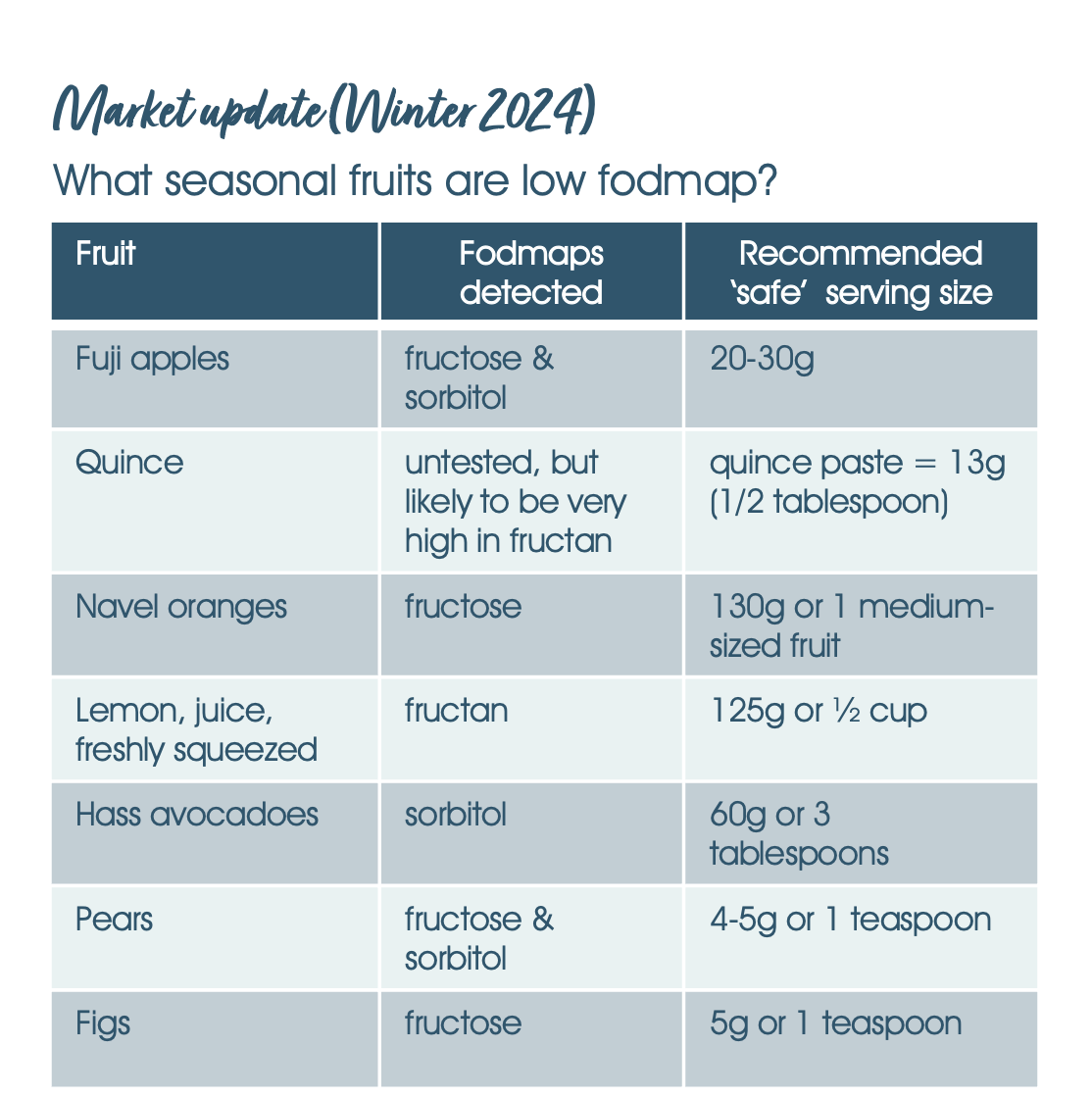What fruit & veg can you eat on the low fodmap diet? (Winter 2024)
Heading to the farmer’s market this weekend? Wondering what fruit & veg (currently in season) you can eat on the low fodmap diet? We’ve pulled together a shopping (and eating) guide based on the latest market report from the Sydney Fresh Fruit & Vegetable Market (11-16 June 2024) and correlated this with the Monash Fodmap App. The result is a guide to filling your basket with fodmap-friendly fruit and veg. Yes, fruit options are sparse but as long as you bypass the apples and pears, you should find some citrus goodies to add to your menu. Over here in Perth, there are also still plenty of green and gold Kiwi fruit to choose from. And there are some wonderful winter veggies that will warm you up! Happy shopping (and eating!)
Fruitful Finds:
The Fuji and Yello apples currently in season are crisp, sweet and juicy. At $4-$6 per kilo, they're a steal for both taste and budget. But… the recommended low fodmap serving size is meagre at 20g-30g, depending on the variety. If you have someone in your household that is willing to share, a slice of apple paired with a sharp cheddar cheese is delightful (as long as you can stop at one slice).
While golden-skinner quince is currently in season, the fruit has not be tested for fodmap content by Monash University. However, the serving size for quince paste is so low (1/2 tablespoon) that we advise admiring this fruit from afar.
In better news for fodmappers… Embrace the peak season for citrus fruits with juicy Navel oranges, priced between $3 -$5 per kilo. Rich in flavour and vitamin C, they make for a refreshing dessert or a zesty addition to savoury dishes. The recommended low fodmap serving size is 130g or 1 medium-sized fruit. Higher serving sizes contain fructose.
Winter is also the peak season for Aussie lemons. Hopefully you or your neighbour have a lemon tree in the backyard, or else you’ll be paying $3-6 per kilo. Lemon juice is great to add to dressings and marinades, with 125g (or ½ cup) being the recommended low fodmap serving size.
Avocado lovers rejoice! Hass avocados are in season and well-priced at $1-$3 each. These creamy delights are packed with 'good' fats and vitamin E, making them a nutritious addition to any meal. Except for fodmappers. The recommended low fodmap serving size is 60g or 3 tablespoons – which is enough to add 1 slice to your salad, but not enough for a salsa.
Packham and Beurru Bosc pears are in season and well priced at $4-6 per kilo but the recommended low fodmap serving size is beyond pitiful at 4-5g, depending on the variety. Winter figs are also available for the next fortnight, but like pears, the low fodmap serving size is pitiful.
Vegetable victories
Whatever it isI love the look of whole roasted cauliflowers with spices and tahini yoghurt currently doing the rounds of social media. Unfortunately, cauliflower is high in mannitol and an intake of 75g (or ¾ cup) may trigger symptoms if you mal-absorb fodmaps.
Given the strong aniseed flavour of fennel, perhaps you may be tempted to add 1/5 bulb or ½ cup (the recommended low fodmap serving size) to your salad or savoury dish.
Brussels Sprouts have the capacity to polarise my family. Currently in season, I believe brussels sprouts can add a nutritious crunch to any meal. The recommended low fodmap serving size is 2.5 medium-sized sprouts per meal (or 53g). Grilled with maple, sprouts are lovely!
Queensland green beans add a versatile crunch to salads, stir-fries or simply steamed. The recommended low fodmap serving size is generous at 15 beans (75g) so it’s a veggie worth exploring and experimenting with.
Chinese cabbage is also worth exploring, with a recommended low fodmap serving size of 1 cup (or 75g). It’s great in stir-fries and is a thrifty buy at $2-5 a head, depending on size. Shred wombok and stir-fry in a hot work with diced pancetta for a tasty side dish or add to a stir-fry at the last minute.
Fresh leeks are a winter staple in many Aussie kitchens. The white bulbs are high in fructans, with a recommended low fodmap serving size of just 14g or 1 tablespoon. The green leafy leek tops however are low in fodmaps (tested to 100g) but they’re woody and fibrous so you’ll need to think creatively if you want to use them., the way you tell your story online can make all the difference.
Conclusion:
We hope this guide helps you to seasonal low fodmap fruit & veg if/when you’re wandering around your local farmer’s market this weekend. Happy shopping and happy eating!




